How to paint a deck is not rocket science, but a few tips will really help. To decide on what product you should use for your deck, read my post on Deck Stain vs Deck Paint, and if you will be painting, read about the best deck paint on the market. I use and recommend to my customers the best products you can afford. It’s a no-brainer to spend more here as it means less time and hassle later on.
Picking colors and materials: I use and highly recommend the largest paint brands: don’t be fooled by advertising. Most advertised paints and stains are nothing like the real thing: save money by spending more on the paint for your deck.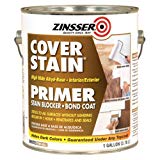
Top-level deck stains save on labor in the long run. Without a doubt, when deck painting, use the very best primer on the market, (Zinsser from Rustoleum). It blocks any tree ‘knots’ from bleeding through your deck paint which is not designed to block stains. (Paint thinner to clean up, but worth it.)
The Short List (with the full explanation below)
- Pressure wash—as described below, this can do 99% of your prep—use water pressure to remove loose paint, but be sure to cover your grounds with large drop cloths. Paint chips fly a long way! The rotating tip shown with the washer below is a necessity: it prevents the wood from getting gouged.
- Let the wood dry totally—bone dry.
- Mask with tape and paper. Cover windows and cover or remove) hardware, etc, and spread drop cloths. There’s a quick trick to using tape and paper together. Cool.
- Create a spacious work base in a shady area and cover with a tarp or plastic (prevents foreign objects from dropping in your buckets etc).
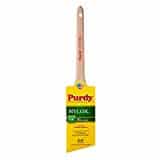
- Primer – mentioned above, use the oil-based exterior and have no fear that you can put latex over that. It’s best to roll small sections with a normal quality (wool/poly, 1/2″ nap) roller cover and then brush (click on image) into all cracks and grooves well with a very good brush. Don’t fear the cost: these will last you a lifetime.
- Repeat with 2 coats of your paint/solid stain: there will be less work brushing into the grooves after priming.
- Soak brushes and rollers etc right away until you have time to clean them: there you’ll see another short post about cleaning brushes: way easier than you remember.
- Spraying deck paint is explained below as well.

My favorite lady on her painted deck
How to paint a deck (big time-saving tip ahead)
1. Deck Prep
2. Deck Painting Tips (plus spraying option)
3. Annual Deck Maintenance
The key point to have a high-quality deck treatment is great prep work and the very best primer you can afford.
All the tools you can possibly need are on our main painting tools page or, for decks, our deck supplies page.
1. Deck Preparation
New Decks: just a pressure wash will do it
If your deck is in good shape (and not pressure-treated wood), jump below to the section on the painting section of how to paint a deck (below). Lucky you. You don’t need to do any sanding or any prep other than a washing (for new decks only). Just below is the section on washing.
When not to wash: Don’t do this with NEW green or brown pressure treated wood. The caution about treating this type of deck is in our other post on what to choose when you Paint or Stain Deck. Never paint a deck with newly installed pressure-treated wood. Wait. Read that post.
How Paint a Deck with Peeling Paint
There are 2 choices for how to paint a deck with peeling paint:
- The pro way: use a rotary grinder to scrape the deck paint (more below)
- The painful way: scrape the peeling deck paint
Scraping is hard work, best done by local teenage boys/girls that want money and are willing to work hard—whatever happened to them? Know any? Me neither.
 Buy a few differently shaped, good quality scrapers. See my favorites listed below. A good scraper is useless without a good file to sharpen every 10-15 minutes of scraping: yes, that often. Dull scrapers suck. In the video, I show how to use a file to sharpen a scraper.
Buy a few differently shaped, good quality scrapers. See my favorites listed below. A good scraper is useless without a good file to sharpen every 10-15 minutes of scraping: yes, that often. Dull scrapers suck. In the video, I show how to use a file to sharpen a scraper.
 Your main scraper is shown. Use the metal file linked above to keep it sharp and you’ll blaze.
Your main scraper is shown. Use the metal file linked above to keep it sharp and you’ll blaze.- My right-hand tool has various edges, including a curve for squeegee a roller cover. It never leaves my person.
- That’s all you need!
Go electric, like Dylan.
We don’t use much muscle in reality.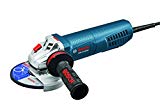
This is the second step (after pressure washing). How to paint a deck with peeling paint: grind it baby. We use the variable speed rotary grinder you see here to remove the peeling paint. We let the customer’s electric bill do the work. A budget way to go is to use a drill attachment. Just never use a high-speed grinder: it melts paint.
This 5-inch grinder will work with the 4½-inch removal pad: the very efficient 3M Sandblaster pads shown here. How it works is demonstrated here on YouTube.
Depending on your grinder, you may need an adapter for this pad.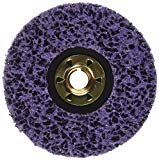
A great extension cord with an awesome rating is here.
Pressure washing a deck
If you like, you can carefully wash your exterior wood with the garden hose (slowly making sure to get all the surface), but this is quite slow. To do it right, a small electric pressure washer is what we use.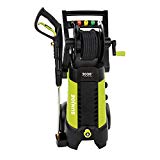
The Sun Joe (this one is medium-powered) will go forever. If you click on the photo, that one has a reel for the hose. Mine paid for itself in under a season as a hard-use professional tool. Eight years later it still works (see my video at the bottom). This one is different from the ones linked at the top of this page. This one has a reel for the hose. Me like. You don’t need an extra long extra hose, just a long extension cord that can handle 15 amps. Great one linked just above.
Key Tip on Powerwashers: you only need one accessory—the rotating tip: this prevents the wood from getting accidentally gouged by the pressure of the water: I never work without one.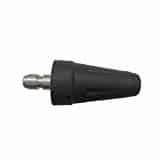
2. How to paint a deck big tip: roll, but never dip your brush!
How to paint a deck the easy (but good) way. What primer and paint to use? We cover that in our post on the best deck paint. When you have that all set…
How to paint a deck in 5 steps:
- Dip roller with a good deal of deck paint or deck stain (just so it’s not dripping).
- Gently roll and let the paint/stain come out of the roller, pressing more firmly as you dry out—think in squares, about 1-yard square or so per dip. Start high and work down to the floor.
- Don’t worry that you’ll lose some paint through the cracks—you can put plastic under if you want to try to save it (and protect the earth).
- Follow up with a brush (no need to dip brush). Work it into the grooves.
- Repeat steps 1-3 until you need more paint/stain.
No brush dipping! You just need to dip your brush when you do corners etc, where the roller cannot let it flow.
Spray that puppy?

Spray painting a deck is 10 times faster than paint rolling or brushing, but there is more waste, obviously.
There are 2 basic types of paint sprayers: airless which are costly but pay for themselves in time saved… and small project sprayers which are slower. The two paint sprayers brands homeowners can trust are Graco (company website) and Wagner (company website).
Read our post just about sprayers: short and sweet.
Two recommendations for two budgets:
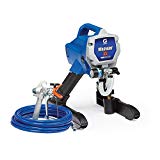 The best non-commercial paint sprayer today is hands down the Graco Magnum X5. It’s reasonably priced and will last a lifetime with proper care. We have an entire post all about sprayers for 3 different budgets.
The best non-commercial paint sprayer today is hands down the Graco Magnum X5. It’s reasonably priced and will last a lifetime with proper care. We have an entire post all about sprayers for 3 different budgets.- The budget choice is the Wagner Flexio 590. It has a very reasonable price for what you get.
If and when you need parts, (the tips do wear out) you can find them easily if you go with one of these major brands.
Some keys to spraying painting a deck:
- Mask what is not getting painted: use plastic and/or canvas and lots of tape. Take your time masking—you’ll save a lot more time in the end. Use a razor knife to get sharp lines or come back later to cut edges with a brush (I do this).
- Practice first: In a less visible area or on some cardboard, move your sprayer hand at a uniform speed, and when you change direction, you make a quick flick of the wrist so you don’t have paint build-up (sags and runs).
- Spraying Oil? Soak the sprayer nozzle in paint thinner (or just gasoline if you are in a pinch) right away when done. Have your cleanup station ready–don’t let your tip get dry.
- Spraying Latex? Soak the sprayer tip in a bucket of water when you put it down to do something else other than spray: keep it wet as it will clog fast, especially on a hot day.
- Use the best deck paint and you should have no problem covering in one coat in the best case.
- A short video from Graco is very good: you won’t need anything more than this video.
3. Annual Maintenance
This is necessary if you used deck paint or opaque stain, but not so much if you use semi-transparent deck stains and similar products.
Sorry to tell you, but on top of all that, you have to do annual upkeep: it’s easier than doing nothing for years, then scraping the entire thing all at once. This work gets old fast!
Just go around one dry day per year in the summer and look for cracks. Scrape (or blast with the pressure washer) the loose paint off, you know, like Steve Martin doing dentistry.
Then sand the edges with some course-grit sandpaper. Lastly, hit with the same primer recommended above, (or just the stain if you are doing stain), let dry, and then 2 coats of your finish paint/solid stain, etc.
This is easier than waiting for years while your deck paint cracks and then you have to do all of it again. Just stay on top of the problem!
Tools you will need
- Tools? The list of any tool you could possibly need is on our deck tool page.
- Need more? Our complete list of tools for all types of painting jobs.
- Don’t like cleaning? Read about the best way to clean a paintbrush: you will make them last and last. Read about how to clean paint rollers: easy!
Related:
Here is our deck supplies page
Best Deck Stain and Sealer: Complications Simplified
Spray Wood Stain – Zero-Maintenance Deck Stain Treatment
How to Stain a Deck Quickly, the Right Way
Best Deck Paint (with a Big Word of Caution)
Paint or Stain Deck? (bonus: Deck Restore Products That Don’t Work)
Be sure to have all the painter tools that you need
Good luck. Let me know in the comments if we missed anything.
Questions about how to paint a deck: let us know in the comments.
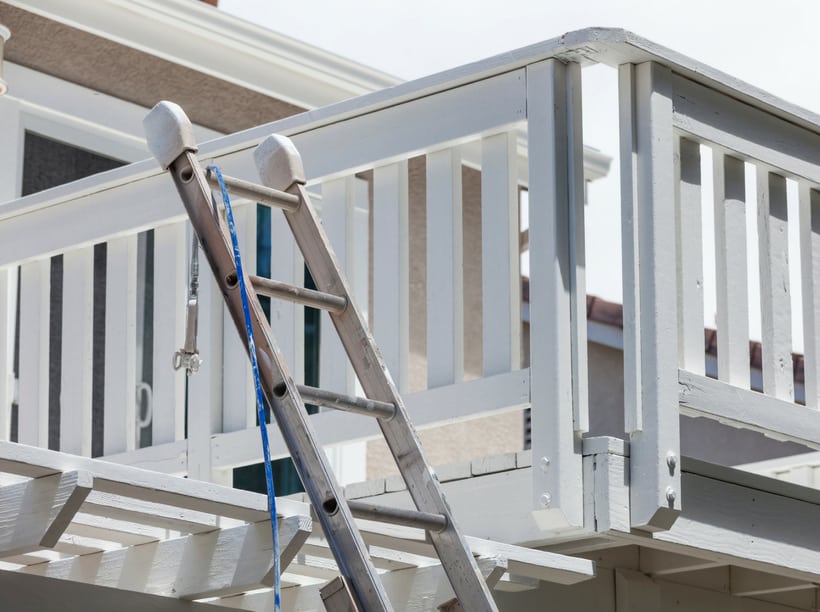
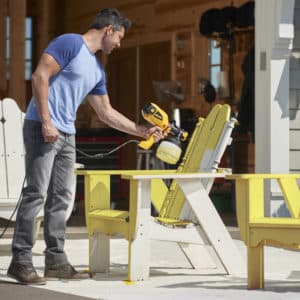
Thanks. It says in a pinch so it’s ok with me.
Great site Brad, wished I had found this the first time I had to make a decision on coating my deck. Question is have is painting handrails and what you recommend. I’ve had a problem with the paint peeling pretty quickly. Wood is dry (we had weeks this summer with no rain, low humidity) and I primed with Zinsser latex after sanding. Paint was Valspar’s interior/exterior paint and I noticed the back railing (north side) is starting to break up in two places on one board yesterday, the rest doesn’t show similar failure. On the south side, railings all look good. On the west side, I have some railings going from the top to lower deck that my carpenter replaced a few years ago, that paint is still in good shape. Is it because they are sloped? I asked him what he used and he wasn’t sure. Typically he uses Zinsser for primer but couldn’t remember the paint.
Years ago when I first had to recoat the deck I used a Behr product, solid stain, and it lasted many years. Where it is under cover, it held up much better than the product more exposed to the elements. When I recoated it, I went with a Sherwin Williams product. Can’t say I have been as impressed with that.
It’s like a war. Nothing lasts for long. My philosophy is to take a few hours every summer and scrape, prep and paint all the cracks. By next year, there will be more but it never gets out of control. Best of luck, soldier.
b
Hi Brad,
Thanks for all the online info!
I want to paint a wood deck that is already painted and the paint is in good shape, no peeling, not chalky. It is a little glossy so I’m thinking to use Zinnser Cover Stain or Bulls Eye 123 as a primer to adhere to the current paint. I notice the directions for both say “not intended for application to floors, decks, roof surfaces or any surfaces subject to immersion or prolonged contact with water.”
There would be no immersion or prolonged contact with water so do you think they are both ok to use? I would prefer 123 to avoid solvent exposure but could use Cover Stain if you think it would be a better primer for an exterior deck floor surface.
Thanks much…..Rob
I would be careful here. If the new paint cracks which it will, the primer will stay wet and that’s what they are warning of.
Do the latex vs oil test (on this site) and if latex, just sand and re-coat with new paint, no primer.
Prime bare wood only with 123 etc, fine. If oil, you need sanding and a good exterior bonding primer. Not sure what I’d use then. I doubt it’s oil.
Brad,
What can I put over a painted deck to keep it from scratching? (I used Sherwin-Williams Emerald Acrylic – They recommended that over the porch and floor because I wanted a gloss finish.)
Love your website! Thanks!
Not sure who recommended it… SW? I guess they would!! But that is a very high quality paint and you would be fine. I don’t think ANY paint or stain will prevent scratching. Probably the plastic chair pads would be far more important.
I can only say this in general: the more you spend ;the better quality finish you get. It’s the raw materials that go into SW and Ben Moore. I always talk customers into spending a lot on materials…and it makes us painters look good too.
Good luck
b
hello brad,
i want to paint the underside of my deck but stain the top surface how would you approach this?
With a roller and brush, not spray. Then spray the stain on top and get in between the wood pieces. The stain that drips on the paint will not be a problem, but will leave a stain.
Brad, I’m painting a new balcony made with untreated Douglas fir. Should I use a water repellent preservative, oil or latex based primer and then finally exterior paint? Or is this overkill? Any suggestions?
Not at all overkill. Use the best if you can afford it. The water repllent and primer may not like each other. My approach will be oil primer, best quality on the market, then two coats of Ben M exterior Aura or some other top level ext paint.
Good luck!
ps, don’t paint in the sun if you can avoid it: shade the area in the sun
Hi Brad, if I repaint my old front porch (pressure treated) which has flaking paint and some new boards and i prime it with a white primer cover stain or BIN (oil based) then follow up with 2 top coats of paint (gray) when the porch weathers in a few years will the white primer show through? Also I’m aware you can have the primer tinted but i cant find any good primer close to the dark gray color im using. thanks for your help!
Sorry for the delay… was on vacation.
Careful tinting primers: ask a paint store. They know how much tint changes primer.
Your primer showing through will not be your problem with weathering. All paint is temporary, and when it goes it will crack and all the layers will peel at once. My advice is to fix the cracks every year once they start.
Yes BIn is a great primer: just check that it’s the exterior one.
Ah, home maintenance.
b
very good article. Thank you
Hello Brad,
Can you recommend a primer comparable to Zinsser Cover Stain Primer? I used it on half of my boat dock with your recommended top coat, and it looks great (on new treated wood that i let thoroughly dry). But now that primer is out of stock (ordered through Home Depot), and i need to finish my job. Your advise would be greatly appreciated!
Use BIN. Same company. Find the one that matches. IF you used water based, there is a BIN waterbased. Alcohol, or oil based? Same thing.
I hope this helps.
Read this.
Good luck.
Wow
Hi, we had planned on hiring someone to completely rebuild our deck this year, but for obvious reasons that won’t happen now. My plan B is to simply paint the deck. There is no pealing or chipping paint or anything like that so I won’t be doing any sanding or cleaning. It just has to last this summer and then next year I’ll have it rebuilt. What would be the best paint to use in this scenario? I’m thinking 3 or 4 coats of acrylic, or maybe a latex paint?
I see. Well, I’d go low budget …as low as possible. I’d look for the lowest cost exterior paint and put on 1 or 2 coats, but probably not much need for more. Why bother? Just for looks right?
Good luck!
B
Hey Brad! Great tips.
Hi!
We are about to re-paint our deck (no idea when it was painted last or what was used as we are the new owners) Some areas are peeling but others look fine. Can I just scrape the paint off in the areas where it doesn’t look great or do I need to remove all old paint before I prime and repaint? Thanks!
Thanks. Hard work clearly brings great websites to the top of a google search.
hello! i pressure washed my cedar deck and it looks nice and clean – it is a 2 year old green treated deck that just had thompsons water seal on – i didn’t know it wasn’t the best to use! There are some lines from where the pressure washer went back and forth – do you have a suggestion on how to get that out or do i worry about it because most likely i will use the stain-seal you suggested the semi transparent from amazon ? thanks! sarah
Yes, Thommy sure can convince you on TV. But that stuff just fades away, like an old soldier.
By lines, I’m not sure what you mean. You went in to the wood too far because you did not have a rotating head on the washer?
I would first take the new stain or product you will use and do a test in a spot…let dry and see if you can tell the difference.
In time anyway, the wood will recover if you did not gouge it… Like Thompson gouged you!
ha ha
So get your product, if the EcoWood, and mix a cup … try your best to guess about ratio. If color, use a drop or two. … Or just mix the whole thing and have at it.
I suspect you’ll be fine… again..in time this will fade most likely. If you can email me a pic, I could say more.
Good luck,
b
Hi Brad,
I love your website it help me a lot When we painting our first house this spring. Now we moved on to restaining the deck. It currently has a solid stain that was coming off in big pieces. We pressure washed it and used a wood cleaner and more of the old paint came off. I then put on citrus stripper and more paint came off but it’s very slow going. Is it possible to remove all of the solid stain and then go to semi-transparent?
I called one company and they said we have to put a solid stain back on because we could never really get all of the current solid stain out of the wood. Is this accurate?
Would our next step be sanding? Would we use a wood brightening product after sanding before staining?
If we have to solid stain again we will but I thought I’d ask. Thank you for any advice you can give us.
Hi. I see your photo clearly, thanks. Well, if you can grind/sand the wood down past where the previous paint/solid stain was able to penetrate, yes you could use semi-transparnet…. But can you do this? Difficult. Test in a spot. Search this site for ‘grinder’ and look at that tool and the paint removal pad. You may very well have success with a power tool. I hope you can because semi-trans has much less upkeep: no peeling. Just a pressure wash and re-stain. Nice.
Also if you take it all off, search this site for “zero” as in no maintenance deck stain. Once for life. I used it on mine. but I’m lazy.
If you go solid stain, go with a very high quality and get the deck very clean and very dry. Brighteners are helpful, but I rarely used them.
Let me know here if you need anything else….other than for me to do it for you! …the lazy thing.
Enjoy!
B
Thanks Guys, this will make my Mother’s day gift of painting her 400 sf deck a bit less stressful.